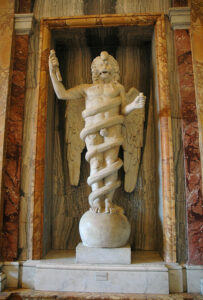Podcast episode
June 9, 2021
Episode 120: Mysteries of the Rock-Born God: The Roman Cult of Mithras







Works Cited in this Episode:
Primary:
- Justin Martyr on the mysteries of Mithras’ sacred meal as an unholy imitation of the Eucharist: Apol. 61: ‘… which the wicked devils have imitated in the mysteries of Mithras, commanding the same things to be done. For, that bread and a cup of water are placed with certain incantations in the mystic rites of one who is being initiated, you either know or can learn.’
- Jerome, Epistle to Læta Chapter 2: ‘… did not your own kinsman Gracchus whose name betokens his patrician origin, when a few years back he held the prefecture of the City, overthrow, break in pieces, and shake to pieces the grotto of Mithras and all the dreadful images therein? Those I mean by which the worshippers were initiated as Raven, Bridegroom, Soldier, Lion, Persian, Sun-runner, and Father? Did he not, I repeat, destroy these and then, sending them before him as hostages, obtain for himself Christian baptism?’
- Syriac Christian testimony to the dies natalis invicti, 25 December, having been appropriated by Christians: ‘It was in fact customary among the pagans to celebrate the festival of the Sun’s birthday on 25th December and to light bonfires in honour of the day. They even used to invite the Christian population to these rites. But when the teachers of the Church realised that Christians were allowing themselves to take part, they decided to observe the Feast of the true Birth on the same day.’ Translation Clauss 2000, 66, cited from Corpus inscriptionum Latinarum I, second edition, 338-9.
- The Orphic lamellæ: see Episode 23.
- Plato’s Myth of Er: see Episode 33 .
- Apuleius’ account of initiation into the Isis-mysteries: see Episodes 12 and 73.
- References to Mithras Phanes: see the rock-birth with Mithras as Phanes from Vercovicium/Housesteads, Vermaseren 860; Vermaseren 475=Moretti, Inscriptiones Græcæ urbis Romæ 108; Nonnos of Panopolis, Dionysiaka 21.248-9, 40.400; Zenobius 5.78 ap. Paroemiogr.
- References to initiatic ordeals in Mithraism: The frescoes from the Capua Vetere Mithræum may depict initiation-scenes: see Vermaseren 1956-60. Gregory of Nazianzen Or. 4.70: the ‘tests of the mysteries of Mithras’. Suda 3.395/1045 Adler, s.v. Μίθρου: ‘The Persians believe the sun to be Mithras and they offer to him many sacrifices …. no one would be able to be initiated into his cult, unless, going through several graded ordeals, he shows himself holy and free from passion.’ We have several fanciful late Christian testimonies making the initiations almost impossibly rigorous (see Migne PG 36: 989, ‘Nonnos’, and PG 38: 506, Cosmas of Jerusalem.
- Papyrus fragment (P. Berol. 21196) of a Mithraic ‘catechism’ for the grade of Leo/Lion: see Brashear 1992 below.
Secondary:
- Franz Cumont. Textes et monuments figurés relatifs aux mystères de Mithra. Lamartin, Bruxelles, 1896-9, 2 vols. Idem. Les mystères de Mithra. Paris, 1902, 2nd ed.
- For the proceedings of the first conference of Mithraic studies, see Hinnells 1975 below.
- Clauss on the Mithraic grades having been reserved for the ‘priests’: see Clauss 1990 below.
Recommended Reading:
For a bibliographic survey up to c. 1980, see Beck 1984. The majority of the data discussed in this episode (and much, much more) can be found in Vermaseren 1956-60, which remains the standard reference-work.
The website The New Mithræum has an interactive map of Mithræum sites across the Mediterranean. Roger Pearse maintains a web-based Mithraic resource chock-full of photos and other goodies, and very conscientiously documented.
See also:
- R.L. Beck. Mithraism since Franz Cumont. ANRW, II(17.4):2002–115, 1984.
- H Bloch. The Pagan Revival in the West at the End of the Fourth Century. In A. Momigliano, editor, The Conflict Between Paganism and Christianity in the Fourth Century, pages 193–218. Clarendon, Oxford, 1963.
- William M. Brashear. A Mithraic Catechism from Egypt: P. Berol. 21196. Holzhausen, Wien, 1992.
- Manfred Clauss. Die sieben Grade des Mithras-Kultes. ZPE, 82:183–94, 1990.
- Idem. Cultores Mithræ: Die Anhängerschaft des Mithras-Kultes. Number 10 in HABES. Franz Steiner Verlag, Stuttgart, 1992.
- Idem. The Roman Cult of Mithras: The God and his Mysteries. Edinburgh University Press, Edinburgh, 2000.
- W. Fauth. Plato Mithriacus oder Mithras Platonicus? Art und Umfang platonischer Einflüsse auf die Mithras-Mysterien. Göttingische Gelehrte Anzeigen, 236:36–50, 1984.
- J.R. Hinnells, editor. Mithraic Studies: Proceedings of the First International Congress of Mithraic Studies. Manchester University Press, Manchester, 1975. 2 vols.
- H.M. Jackson. The Meaning and Function of the Leontocephaline in Roman Mithraism. Numen, 32:17–45, 1985.
- R. Pettazzoni. The Monstrous Figure of Time in Mithraism. In Essays in the History of
Religions, pages 180–92. Brill, Leiden, 1967. - A. Schütze. Mithras-Mysterien und Urchristentum. Urachhaus, Stuttgart, 1972.
- R. Turcan. Mithras Platonicus: Recherches sur l’hellénisation philosophique de Mithra. Number 47 in EPRO. Brill, Leiden, 1975.
- Idem. Mithras et le mithriacism. Les Belles Lettres, Paris, 1981.
- M.J. Vermaseren. Corpus inscriptionum et monumentorum religionis Mithriacæ. Martinus Nijhoff, The Hague, 1950-60. 2 vols.
- Idem. Mithras: The Secret God. Chatto and Windus, London, 1963.
- V.J. Walters. The Cult of Mithras in the Roman Provinces of Gaul. Number 41 in EPRO. Brill, Leiden, 1974.
Themes
Aiôn, Astrology, Initiation, Julian, Mithraic Mysteries, Mithras, Mithrasliturgie, Mystery-Cult, Porphyry, William Stukeley

Sigmund Schilpzand
October 31, 2021
I was just in Londinium, and visited the Mithraeum. And it occurred to me: how about an Esoteric Excursion!?!?!?! (covid permitting)
Lb Behrendt
August 5, 2023
what’s better than this: guys being dudes being sun gods eating a banquet on a dead bull. love this for them!
Earl Fontainelle
August 5, 2023
Good times.